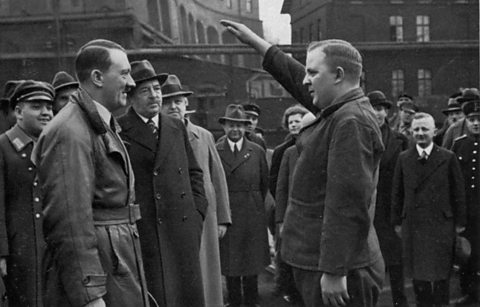The impact of war on the German people
In Germany in 1914, at the beginning of World War One, there had been great enthusiasm for war.
In 1939, this was no longer the case as the vast majority of Germans only reluctantly supported the war.
The early period of the war, 1939-41, was successful for the German army and there was little ill-effect on the civilian population.
Successful blitzkriegLightning war - a military offensive used by the German army in WW2. It used a combination of speed, surprise air attacks and overwhelming land forces to destroy the opposition. tactics meant that Germany was able to take resources from conquered territories such as Poland, Holland and Belgium.
In fact, early military successes actually gave rise to celebrations amongst the German people and caused an increase in HitlerÔÇÖs popularity.
Initially propagandaPutting forward biased information to persuade people to believe a particular point of view. was not needed very much as victories arrived at the start of the war, but as the war drew on and German success became more limited, the role of propaganda increased.
Joseph Goebbels urged the people to work harder and to make even greater sacrifice to achieve victory, especially after German cities were bombed.
Air raids and bombing
Initially, the British - later joined by the United States, and to a lesser extent the USSR - targeted their bombing raids on industrial and military targets.
However, in 1942, the Allies switched to a policy of ÔÇśarea bombingÔÇÖ, i.e. targeting large industrial cities with incendiary bombs (bombs designed to cause fires), and not distinguishing between military and civilian targets.
A number of key cities came under attack (not including Berlin, which was subject to relentless attacks in the latter part of the war).
- On 30 May 1942: the first British ÔÇśthousand bomber raidÔÇÖ was launched against Cologne.
- July and August 1943: Hamburg was bombed on two occasions. As a result of the second air raid, two thirds of the cityÔÇÖs buildings were destroyed and tens of thousands died.
- February 1945: Dresden was attacked over two nights with 70 per cent of buildings destroyed and around 25,000 people killed.
Results of the bombings in Germany
- 3.6 million homes were destroyed.
- 7.5 million people were made homeless.
- 300,000 ÔÇô 400,000 civilians were killed.
- Many people fled to the countryside.
- The raids had a limited impact on the morale of the German population as Nazi propaganda tended to downplay their destruction and the number of deaths.
- The raids strengthened rather than weakened the determination of the Germans.
- There was severe overcrowding in the buildings left habitable.
'Total War'
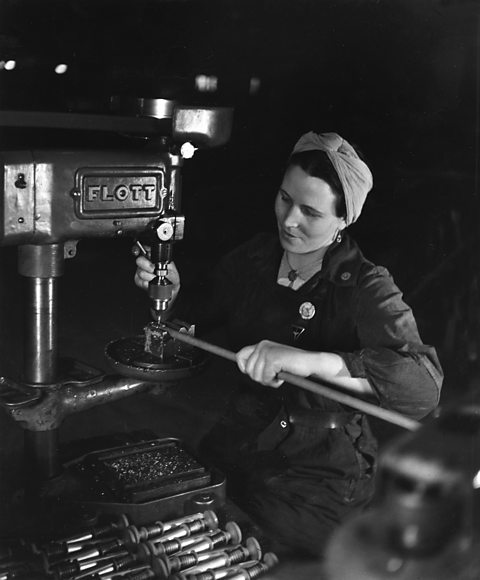
'Total War', first declared by Joseph Goebbels in February 1943, was an idea that all of GermanyÔÇÖs economic activity would be focused solely on winning the war.
By 1943, it was clear that Germany was not winning and that its economy was not able to provide the country with all that it needed to succeed in the kind of war being fought.
Therefore, the economy needed to be changed.
Albert Speer had become Minister of Armaments and Production in 1942 and was given the task of increasing war production within the economy.
He ensured that all production of civilian goods stopped and factories only produced goods which would support the war effort.
As a result, working hours increased, women were brought in to work in factories and foreign workers were even used.

Impact of Speer's plan
Speer had some success:
Improvements attempted:
- More armaments.
- Better planning.
- Improved cooperation between different sectors of the economy and the military.
- More workers.
Successes:
- Panzer III battle tanks were produced twice as quickly.
- The output of workers in munitions went up an average of 60 per cent.
- Weapon production increased by 130 per cent between 1941 and 1943.
Rationing
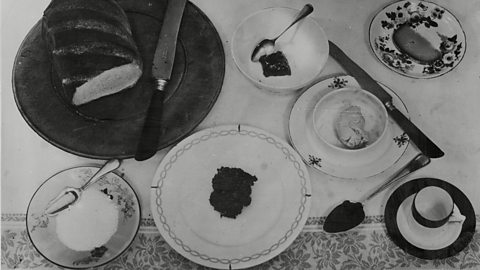
autarkyA closed economy. Hitler's ideology that wanted Germany to cease trade with the outside world and rely entirely on its own resources. and rearmament meant consumer goods were already expensive and scarce before the war and although the main restrictions were not until 1942, there were some problems early in the war.
Food was rationed immediately in 1939, although Germans did not experience chronic shortages until 1944.
Rationing during the war
- The Germans diet became more monotonous, with lots of bread, potatoes and preserves.
- There were meat shortages due to the lack of imports from the USA.
- Parks and gardens were dug up to make vegetable patches.
- Extra rations were given to people considered important to the war effort.
- Clothing was rationed from November 1939 onwards.
- There were coal shortages.
- A flourishing black marketThe illegal trading of goods or services. was created. Luxury clothes and perfume were readily available for the rich.
- Food consumption per person fell 25 percent by 1941.
In general, rationing was accepted with little opposition, especially as food rations were reasonably generous until the middle of the war.
However, in the last year of the war, ration cardA document issued by the authorities entitling its holder to obtain a certain amount of foodstuff. were no longer honoured and shortages of food and clothing were severe.
Labour shortages and the role of women in the workplace
13.7 million German men served in the army during the war, and this created a huge labour shortage on the home front.
As they did during World War One, women played a vital role. They worked in armaments factories and as medics.
There was compulsory agricultural labour service for unmarried women under 25.
In 1943, women aged 17 to 45 had to register for work.
However, only 1 million out of 3 million of those eligible did so.
Of those who registered, about 400,000 were employed because employers and the Nazis still preferred to use prisoners.
Hitler opposed the suggestion to conscriptionCompulsory enrolment in the armed forces. women into the army, but Nazi womenÔÇÖs groups organised collections of clothing for the soldiers on the harsh Eastern front in the USSR.
The Nazis also made extensive use of forced labour, transporting hundreds of thousands of civilians and prisoners of war from Eastern Europe and elsewhere to Germany to keep the war effort going.
By 1943, 21 per cent of the German workforce were foreigners.
Escalation of racial persecution
The outbreak of World War Two spelt disaster for those Jews who had remained in Germany.
Persecution quickly escalated.
By the end of the war, six million European Jews had been exterminated, including over three million from Germany.
World War Two also affected other minorities.
85 per cent of Germany's Sinti and Roma died in concentration camps.
Between 1939 and 1941, over 100,000 Germans with physical and mental disabilities were killed in secret, without the consent of their families.
Ghettos
Immediately after the war broke out in September 1939, the Nazi policy of isolating Jews from the rest of German society intensified.
In Poland, the Jews were herded into overcrowded ghettos in towns such as Lodz, Riga, and Minsk.
Question
What was a ghetto?
Ghettos were segregated areas where Jews were forced to live. They eventually had walls around the areas with armed guards and watch towers.
Warsaw Ghetto
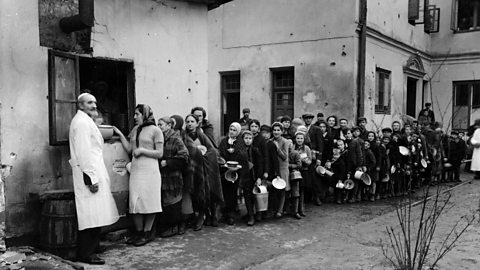
The Warsaw Ghetto was the largest of the Nazi ghettos during World War Two.
Conditions were appalling.
It had 400,000 Jews crammed into an area covering approximately 1 square mile.
95 per cent of the wooden shacks they lived in had no running water or sanitation.
Food was scarce and there was a deliberate policy of starving the population.
Hundreds of thousands died of starvation and disease, such as typhusAn infectious disease spread by lice. It causes a fever and can be fatal..
As the war continued, the Jews were often moved from the ghettos to concentration camps.
The Einsatzgruppen
By the end of 1941, the ghettos and camps were overwhelmed by the number of Jews being sent to them.
Many Jews never even arrived at the camps because they were simply murdered instead.
Four specially created SSThe Schutzstaffel, also known as the Blackshirts. A police/military style organisation created to serve as HitlerÔÇÖs personal bodyguard. In Hitler's Germany they eventually controlled the intelligence, security and police forces, and the extermination of those they considered undesirable. units totalling 3,000 men, called Einsatzgruppen, had been set up to follow behind the German army during its invasion of the USSR.
They were to round up Jews, communistSomeone who believes in the political ideology of communism, a system of running a country in which all means of production such as tools, factories and raw materials, are owned by the community as a whole. Private property does not exist and each individual contributes according to their ability and receives according to their needs. This means there is no hierarchy of social class. officials and Russian army officers, and execute them.
Initially, they targeted Jewish men, but in August 1941 the policy was extended to the entire Jewish population.
The victims were taken to the edge of towns and villages, forced to dig mass graves and then shot and buried in huge numbers.
In September 1941, in a two-day massacre at Babi Yar, Kyiv, nearly 34,000 Jews were killed.
By the end of 1941, 500,000 Jews had been murdered in this way and in total the victims of Einsatzgruppen numbered around 1.2 million.
The Final Solution
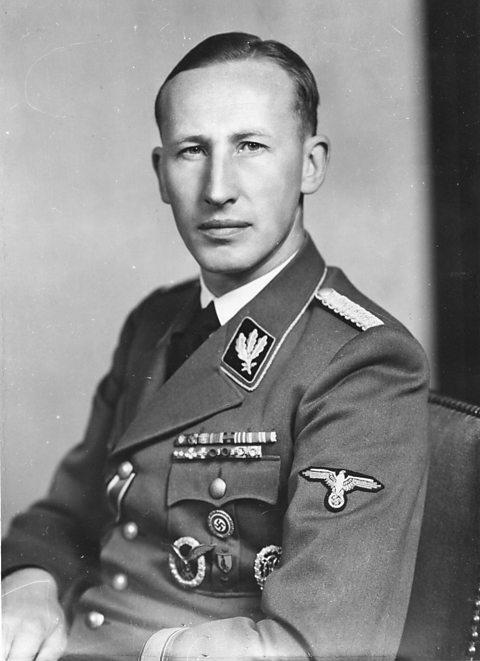
At the end of 1941, Hitler demanded an ÔÇťaggressive policyÔÇŁ to rid Germany of Jews.
On 20 January 1942, Reinhard Heydrich, the Head of the SicherheitsdienstThe intelligence agency of the Nazi Party in Nazi Germany. Also known as SD or Security Service., held a conference in the Wannsee suburb of Berlin to discuss what the new aggressive policy should be.
At this meeting, it was agreed that all Jews under German occupation would be brought to Poland, where those fit enough would be worked to death and the rest exterminated.
This led to the horror of the Nazi death camps, six of which were built specifically to murder those brought to them.

The Death Camps
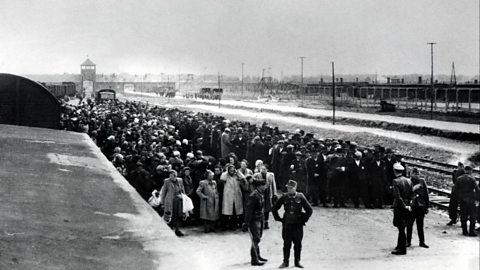
A number of camps were built throughout Eastern Europe, some were solely extermination camps and others were labour and extermination camps such as Auschwitz-Birkenau.
By the end of the war, an estimated 6 million Jews had been murdered by the Nazis.
Jews arrived at the camps on trains, where they were separated into two groups: those fit enough to work and those to be killed immediately ÔÇô usually women, children and the elderly.
The latter group was ushered into what they thought were showers, where they were gassed to death using pellets of cyanide A rapidly acting and potentially deadly chemical that interferes with the bodyÔÇÖs ability to use oxygen. known as Zyklon B.
It took up to 30 minutes for victims to die. Their bodies were then burnt in huge ovens.
Altogether, it is thought around six million Jews were murdered, as well as several million other victims, including SintiThe group of Roma people who lived in central and eastern Europe. and RomaA group of people (Romani) that arrived in Europe in migrations from northern India around the 14th century., homosexuals, Soviet prisoners of war, JehovahÔÇÖs Witnesses and other ÔÇśundesirablesÔÇÖ.
This is known as the Holocaust.
Opposition from young people
There was growing opposition and resistance in Germany to Nazi rule during the war years.
Swing Youth
- These were middle class young people who rejected Nazi values.
- They drank alcohol and danced to jazz music. The Nazis rejected jazz as degenerate and called it 'Negro music', using their racial ideas to oppose this cultural development.
Edelweiss Pirates
- They were made up of primarily working class boys from regions in the west of Germany, such as the Rhineland. This was the main youth opposition group during the war.
- They attacked members of Hitler YouthNazi organisation set up to convert GermanyÔÇÖs young people to Nazism. and were fond of singing anti-Nazi songs. In 1942, over 700 of them were arrested. In 1944, 12 members were publicly hanged after their members in Cologne killed the Gestapo chief.
White Rose Group
- Students at Munich University in 1943, led by brother and sister Hans and Sophie Scholl.
- They published anti-Nazi leaflets, for example on the gassing of children, and marched through the city in protest at Nazi policies. Its leaders were eventually arrested and sentenced to the guillotineAn execution device that used a falling blade to cut off the victimÔÇÖs head..
Opposition from the churches
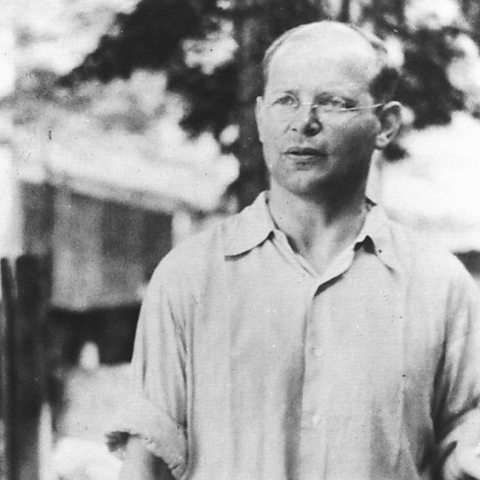
In 1941, Hitler ordered an end to pressure on the churches because he needed the publicÔÇÖs support during the war.
He decided to wait until the end of the war to suppress religion.
This relaxation of pressure meant attendance at services increased, but the churches were not very vocal in defence of others, such as the Jews.
Despite receiving reports from across Europe about the deportation of Jews to extermination camps, Pope Pius XII and most Protestant leaders did not condemn it.
It was left to individual clerics to speak out.
The Catholic Church had one success against the Nazis in 1941 when the Bishop of M├╝nster, von Galen, led a campaign which ended the euthanasia of people with mental disabilities.
Many in the Protestant churches also did not oppose the regime openly.
However, there were examples of resistance, such as Dietrich Bonhoffer, a Protestant pastor in the Confessional Church.
He joined the resistance and was linked to the 1944 1944 bomb plot against HitlerThe attempted assassination of Adolph Hitler on 20 July 1944. Hitler escaped death after a bomb, planted by Colonel Claus von Stauffenberg, exploded at a meeting attended by the F├╝hrer. Hitler survived because a thick leg of the table shielded him from the worst of the blast. and was executed in 1945.
The Prussian Confessional Church also acted and condemned the extermination of people on health and racial grounds.

Opposition within the army
There were various efforts to remove Hitler during the war; the one that came closest to succeeding happened towards the end, when it was becoming clear that Germany would be defeated.
Operation Valkyrie
In July 1944, a group of army officers tried to assassinate Hitler and replace him with a government led by General Ludwig Beck, who had resigned from a senior military leadership position in 1938 due to his opposition to HitlerÔÇÖs foreign policy.
A bomb was planted by Colonel Claus von Stauffenberg at a meeting attended by the F├╝hrer.
It exploded, but Hitler survived because a thick leg of the table shielded him from the worst of the blast.
Retaliation was swift and decisive.
Stauffenberg was shot the same day and 5,000 people were executed in the crackdown on opposition that followed.
The great German military leader Field Marshal Erwin van Rommel was accused of being involved in the plot and was forced to commit suicide as punishment for his involvement.
The effectiveness of opposition to the Nazis up to 1945
There was not a great deal of resistance in Germany during the war.
Most people remained loyal to the regime, even if they were not enthusiastic about it or the war.
Nevertheless, there was widespread grumbling and disillusionment.
Young people were the most influenced by HitlerÔÇÖs propaganda, and only a few groups, like the Edelweiss Pirates and the White Rose worked actively against the regime.
Others, like the Swing Movement, confined their opposition to not complying with some regulations.
The churches did not form major opposition to the Nazis during the war.
Many of their leaders had already been arrested.
Others kept quiet because either they feared persecution or they wanted to retain some presence in Germany so Hitler did not have a completely free hand.
There was greater opposition to the regime from individual Christians than from church leaders.
There were a number of army plots, but there was no effective opposition to Hitler because the military leaders were too busy competing with each other.
Test your knowledge
More on Life in Nazi Germany, 1933-45
Find out more by working through a topic
- count3 of 7
